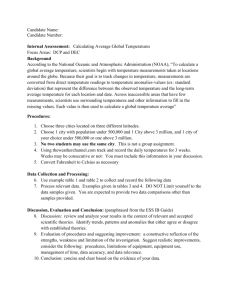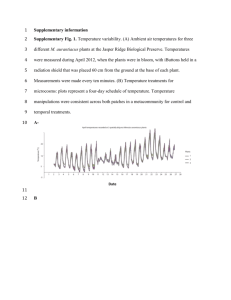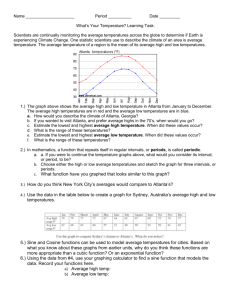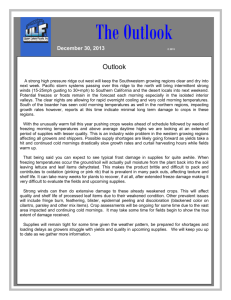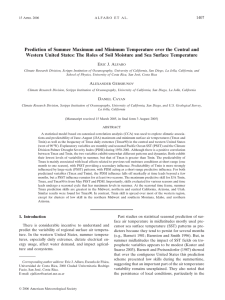Readme_Aux
advertisement
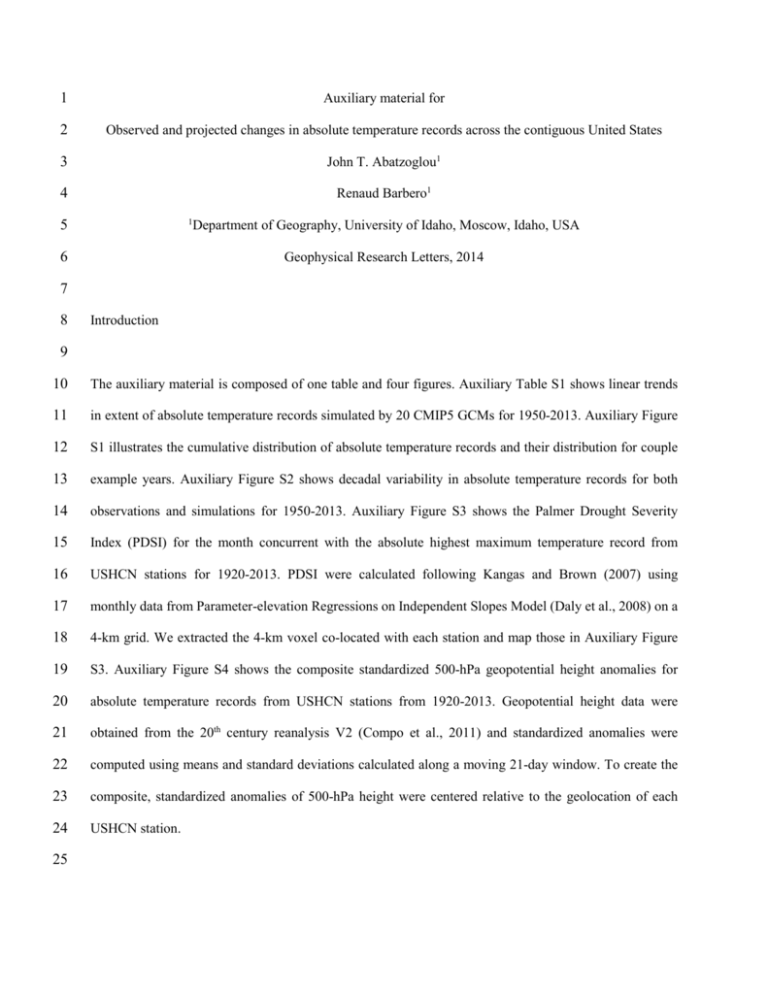
1 Auxiliary material for 2 Observed and projected changes in absolute temperature records across the contiguous United States 3 John T. Abatzoglou1 4 Renaud Barbero1 1 5 Department of Geography, University of Idaho, Moscow, Idaho, USA 6 Geophysical Research Letters, 2014 7 8 Introduction 9 10 The auxiliary material is composed of one table and four figures. Auxiliary Table S1 shows linear trends 11 in extent of absolute temperature records simulated by 20 CMIP5 GCMs for 1950-2013. Auxiliary Figure 12 S1 illustrates the cumulative distribution of absolute temperature records and their distribution for couple 13 example years. Auxiliary Figure S2 shows decadal variability in absolute temperature records for both 14 observations and simulations for 1950-2013. Auxiliary Figure S3 shows the Palmer Drought Severity 15 Index (PDSI) for the month concurrent with the absolute highest maximum temperature record from 16 USHCN stations for 1920-2013. PDSI were calculated following Kangas and Brown (2007) using 17 monthly data from Parameter-elevation Regressions on Independent Slopes Model (Daly et al., 2008) on a 18 4-km grid. We extracted the 4-km voxel co-located with each station and map those in Auxiliary Figure 19 S3. Auxiliary Figure S4 shows the composite standardized 500-hPa geopotential height anomalies for 20 absolute temperature records from USHCN stations from 1920-2013. Geopotential height data were 21 obtained from the 20th century reanalysis V2 (Compo et al., 2011) and standardized anomalies were 22 computed using means and standard deviations calculated along a moving 21-day window. To create the 23 composite, standardized anomalies of 500-hPa height were centered relative to the geolocation of each 24 USHCN station. 25 26 1. Table S1: Linear trends in the % of spatial extent of the US with absolute temperature records from 27 CMIP5 simulations for 1950-2013. Trends are expressed as the difference between the last and the first 28 values from the least square line. * indicates that the trend observed is significant according to a Monte- 29 Carlo test, that is, more than 95% of the simulated trends agree on the sign of the trend. 30 1.1 Column Official acronyms of Global Climate Models used. 31 1.2 Column Linear least squares trend in the highest absolute maximum temperature record. 32 1.3 Column Linear least squares trend in the lowest absolute maximum temperature record. 33 1.4 Column Linear least squares trend in the highest absolute minimum temperature record. 34 1.5 Column Linear least squares trend in the lowest absolute minimum temperature record. 35 36 2. (Auxiliary Figure S1) The cumulative distribution of absolute daily records by year for (a) maximum 37 temperature and (b) minimum temperature for the 1920-2013 period from aggregated station data. The 38 extent of the domain that set or tied records for (c) absolute highest maximum temperatures in 1936, and 39 (d) absolute lowest maximum temperatures in 1985. 40 41 3. (Auxiliary Figure S2) Decadal variability in the spatial extent of absolute records in (a) highest 42 maximum temperatures, (b) lowest maximum temperatures, (c) highest minimum temperatures, and (d) 43 lowest minimum temperatures for GHCN and 20 different climate models from 1950-2013. Data is 44 expressed as a departure from an assumed uniform distribution of records. Climate model results are 45 depicted by the box plots where the interquartile range is shown by the grey envelope, the 20-model mean 46 shown by the black horizontal line and individual model results shown by small circles. 47 48 4. (Auxiliary Figure S3) Palmer Drought Severity Index (PDSI) for month during which absolute highest 49 maximum temperature was recorded for each USHCN station 1920-2013. PDSI values less than -3 are 50 shown by larger circles to emphasize severe drought. 51 5. (Auxiliary Figure S4) Composite standardized 500-hPa geopotential height anomalies for absolute 52 temperature records set from 1920-2012 centered relative to the geographic location of USHCN stations 53 (denoted by the black x on each plot). Solid red (dashed blue) contours are plotted every 0.2σ starting 54 from 0.6σ (-0.6σ) with the 1σ isoline shown in bold. Geopotential height data were obtained from the 20th 55 century reanalysis V2. 56 57 References 58 Compo, G.P., and coauthors, 2011: The Twentieth Century Reanalysis Project. Quarterly J. Roy. 59 60 Meteorol. Soc., 137, 1-28. DOI: 10.1002/qj.776. Daly, C., M. Halbleib, J.I. Smith, W. P. Gibson, M. K. Doggett, G. H. Taylor, J. Curtis, and P. A. Pasteris 61 (2008) Physiographically-sensitive mapping of temperature and precipitation across the conterminous 62 United States. International Journal of Climatology, 28: 2031-2064. 63 64 65 66 67 Kangas, R.S. and T.J. Brown (2007) Characteristics of U.S. Drought and Pluvials from a High-Resolution Spatial Dataset, International Journal of Climatology, 27, 1303-1335. 68 bcc-csm1-1 canESM2 CCSM4 CNRM-CM5 CSIRO-Mk3-6-0 GFDL-ESM2M HadGEM2-ES365 HadGEM2-CC365 inmcm4 IPSL-CM5A-LR IPSL-CM5A-MR MIROC5 MIROC-ESM MIROC-ESM-CHEM MRI-CGCM3 NorESM1-M bcc-csm1-1-m BNU-ESM IPSL-CM5B-LR GFDL-ESM2G Highest TMAX Lowest TMAX Highest TMIN Lowest TMIN 3.13* 4.55* 4.42* 3.14* 4.32* 4.23* 3.96* 3.85* 3.00* 4.86* 4.33* 2.99* 0.49 1.86* 1.87* 3.66 4.49* 5.61* 4.43* 4.97* -1.94* -1.11 -0.05 0.55 -1.10 0.10 -0.02 -0.56 -0.87 0.14 -0.65 -0.65 -1.21* 0.35 -2.64* -0.91 -0.28 -1.57* -0.56 -0.53 1.36* 2.97* 3.15* 1.79* 3.10* 2.15* 3.07* 1.42* 1.86* 3.33* 3.20* 2.33* 2.75* 2.69* 1.29* 2.11* 1.92 3.69 3.31 1.98 -2.03* -0.86 -1.48* 1.14 -0.84 0.19 -0.07 -1.00* 0.92 -0.48 -1.22 -0.63 -2.16* 0.19 -2.52* 0.23 -1.31 -1.07* -0.03 -1.22* 69 70 71 Table S1: Linear trends in the % of spatial extent of the US with absolute temperature records from 72 CMIP5 simulations for 1950-2013. Trends are expressed as the difference between the last and the first 73 values from the least square line. * indicates that the trend observed is significant according to a Monte- 74 Carlo test, that is, more than 95% of the simulated trends agree on the sign of the trend. 75 76 f(# of absolute records) 1 a) CDF of record years (TMAX) 1 0.8 0.8 0.6 0.6 0.4 0.4 0.2 01 Highest TMAX Lowest TMAX 920 1930 1940 1950 1960 1970 1980 1990 2000 2010 c) Highest TMAX in 1936 0.2 01 b) CDF of record years (TMIN) Highest TMIN Lowest TMIN 920 1930 1940 1950 1960 1970 1980 1990 2000 2010 d) Lowest TMAX in 1985 77 78 79 Figure S1: The cumulative distribution of absolute daily records by year for (a) maximum temperature 80 and (b) minimum temperature for the 1920-2013 period from aggregated station data. The extent of the 81 domain that set or tied records for (c) absolute highest maximum temperatures in 1936, and (d) absolute 82 lowest maximum temperatures in 1985. 83 84 85 86 Figure S2: Decadal variability in the spatial extent of absolute records for (a) highest maximum 87 temperatures, (b) lowest maximum temperatures, (c) highest minimum temperatures, and (d) lowest 88 minimum temperatures for GHCN and 20 different climate models from 1950-2013. Data is expressed as 89 a departure from an assumed uniform distribution of records. Climate model results are depicted by the 90 box plots where the interquartile range is shown by the grey envelope, the 20-model mean shown by the 91 black horizontal line and individual model results shown by small circles. 92 93 94 Figure S3: Palmer Drought Severity Index (PDSI) for month during which absolute highest maximum 95 temperature was recorded for each USHCN station 1920-2013. PDSI values less than -3 are shown by 96 larger circles to emphasize severe drought. 97 98 99 100 Figure S4: Composite standardized 500-hPa geopotential height anomalies for absolute temperature 101 records set from 1920-2012 centered relative to the geographic location of USHCN stations (denoted by 102 the black x on each plot). Contours are plotted every 0.2σ starting from 0.6σ with the 1σ isoline boldened. 103 Geopotential height data were obtained from the 20th century reanalysis V2. All contours plotted were 104 statistically significant at p<0.05.



